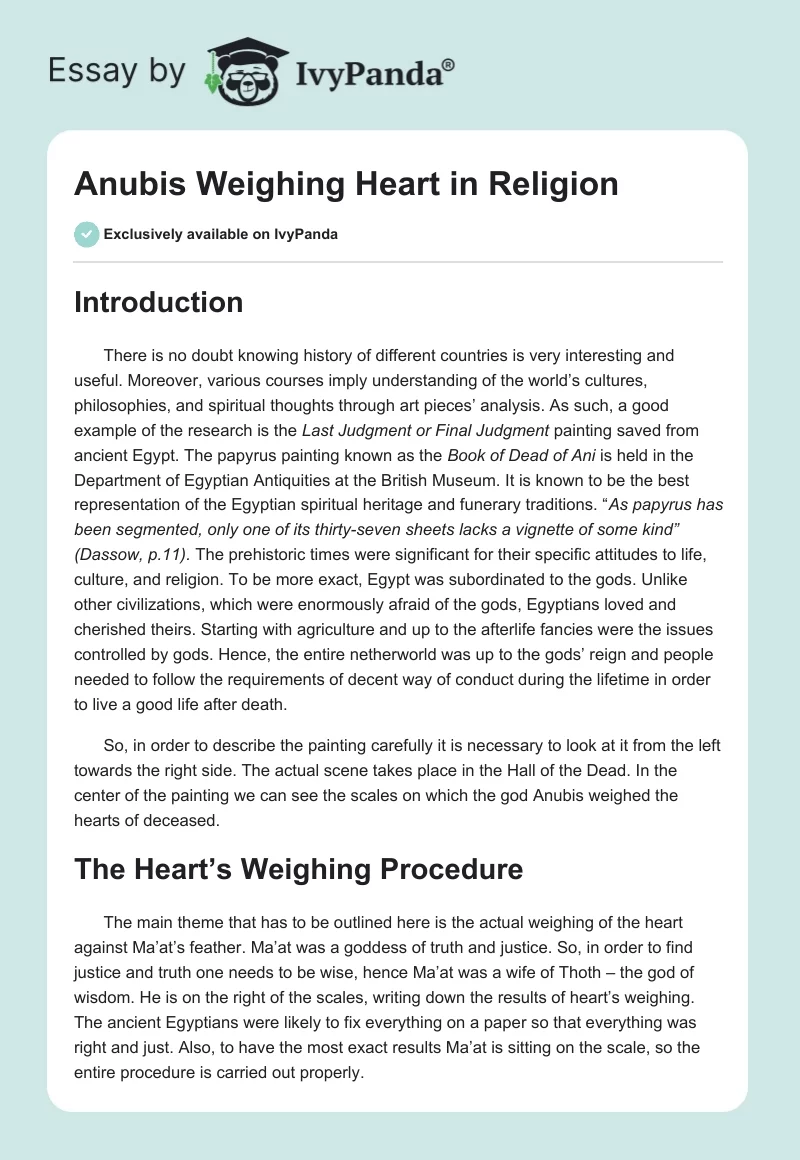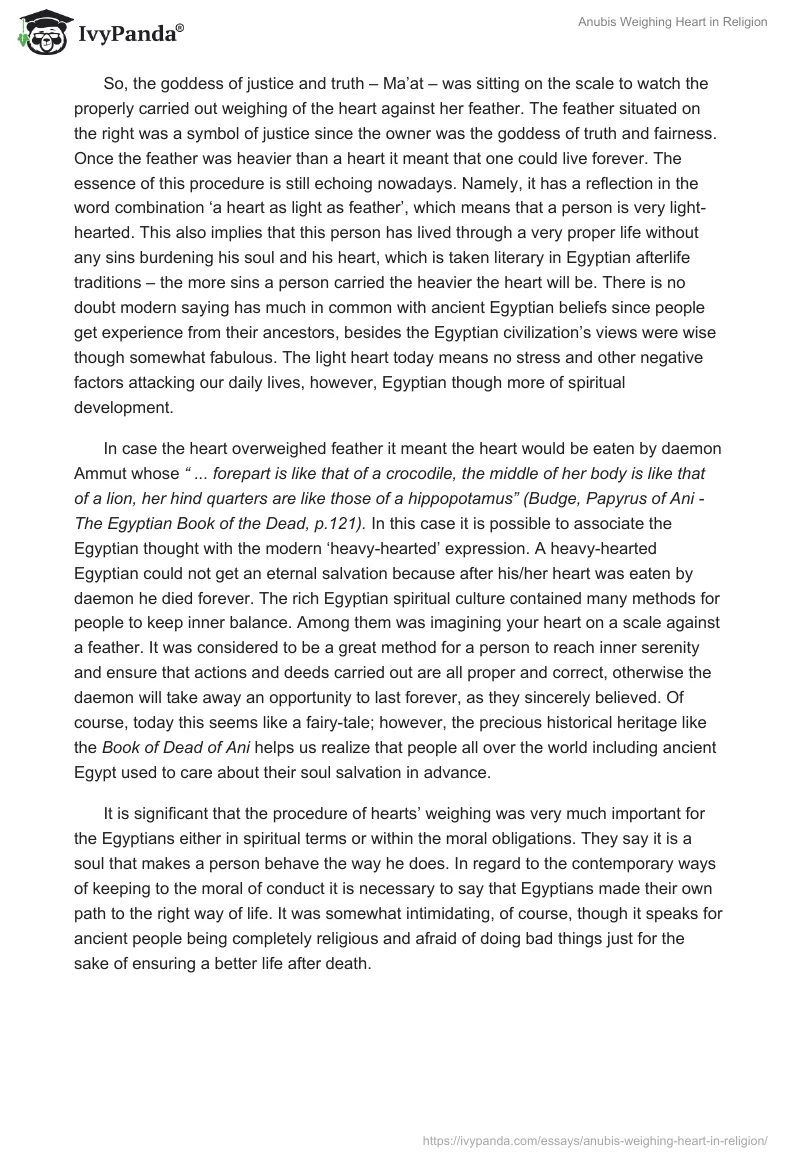Introduction
There is no doubt knowing history of different countries is very interesting and useful. Moreover, various courses imply understanding of the world’s cultures, philosophies, and spiritual thoughts through art pieces’ analysis. As such, a good example of the research is the Last Judgment or Final Judgment painting saved from ancient Egypt. The papyrus painting known as the Book of Dead of Ani is held in the Department of Egyptian Antiquities at the British Museum. It is known to be the best representation of the Egyptian spiritual heritage and funerary traditions. “As papyrus has been segmented, only one of its thirty-seven sheets lacks a vignette of some kind” (Dassow, p.11). The prehistoric times were significant for their specific attitudes to life, culture, and religion. To be more exact, Egypt was subordinated to the gods. Unlike other civilizations, which were enormously afraid of the gods, Egyptians loved and cherished theirs. Starting with agriculture and up to the afterlife fancies were the issues controlled by gods. Hence, the entire netherworld was up to the gods’ reign and people needed to follow the requirements of decent way of conduct during the lifetime in order to live a good life after death.
So, in order to describe the painting carefully it is necessary to look at it from the left towards the right side. The actual scene takes place in the Hall of the Dead. In the center of the painting we can see the scales on which the god Anubis weighed the hearts of deceased.
The Heart’s Weighing Procedure
The main theme that has to be outlined here is the actual weighing of the heart against Ma’at’s feather. Ma’at was a goddess of truth and justice. So, in order to find justice and truth one needs to be wise, hence Ma’at was a wife of Thoth – the god of wisdom. He is on the right of the scales, writing down the results of heart’s weighing. The ancient Egyptians were likely to fix everything on a paper so that everything was right and just. Also, to have the most exact results Ma’at is sitting on the scale, so the entire procedure is carried out properly.
So, the goddess of justice and truth – Ma’at – was sitting on the scale to watch the properly carried out weighing of the heart against her feather. The feather situated on the right was a symbol of justice since the owner was the goddess of truth and fairness. Once the feather was heavier than a heart it meant that one could live forever. The essence of this procedure is still echoing nowadays. Namely, it has a reflection in the word combination ‘a heart as light as feather’, which means that a person is very light-hearted. This also implies that this person has lived through a very proper life without any sins burdening his soul and his heart, which is taken literary in Egyptian afterlife traditions – the more sins a person carried the heavier the heart will be. There is no doubt modern saying has much in common with ancient Egyptian beliefs since people get experience from their ancestors, besides the Egyptian civilization’s views were wise though somewhat fabulous. The light heart today means no stress and other negative factors attacking our daily lives, however, Egyptian though more of spiritual development.
In case the heart overweighed feather it meant the heart would be eaten by daemon Ammut whose “ … forepart is like that of a crocodile, the middle of her body is like that of a lion, her hind quarters are like those of a hippopotamus” (Budge, Papyrus of Ani – The Egyptian Book of the Dead, p.121). In this case it is possible to associate the Egyptian thought with the modern ‘heavy-hearted’ expression. A heavy-hearted Egyptian could not get an eternal salvation because after his/her heart was eaten by daemon he died forever. The rich Egyptian spiritual culture contained many methods for people to keep inner balance. Among them was imagining your heart on a scale against a feather. It was considered to be a great method for a person to reach inner serenity and ensure that actions and deeds carried out are all proper and correct, otherwise the daemon will take away an opportunity to last forever, as they sincerely believed. Of course, today this seems like a fairy-tale; however, the precious historical heritage like the Book of Dead of Ani helps us realize that people all over the world including ancient Egypt used to care about their soul salvation in advance.
It is significant that the procedure of hearts’ weighing was very much important for the Egyptians either in spiritual terms or within the moral obligations. They say it is a soul that makes a person behave the way he does. In regard to the contemporary ways of keeping to the moral of conduct it is necessary to say that Egyptians made their own path to the right way of life. It was somewhat intimidating, of course, though it speaks for ancient people being completely religious and afraid of doing bad things just for the sake of ensuring a better life after death.
A Symbol of Heart
It is interesting that Egyptians used the heart as a symbol of a person’s soul. It was believed that the heart was somewhat close to a memory container. To be more exact, heart lying on scale was the substance that held the memory of emotions, thoughts, and conscience. It is understandable today within our culture and reality, since people still say they love or hate with all their heart. Talking about heart as a soul container, Egyptians knew very well that their heart had to be free of heavy thoughts in order to move to the next spiritual level. Also, they used to paint the scale of heart weighing on the tombs. This way they thought their soul’s survival would be guaranteed.
Anubis in the Painting
A great role is played by Anubis in the painting and within the entire belief of afterlife world. “Anubis performs the actual work with the Great Scales” (Budge, From Fetish to God in Ancient Egypt, p.37). Probably, this was so because jackal is usually associated with an animal wandering amongst tombs. He was the one to lead the deceased to the Hall of the Dead and to the final judgment. Anubis was the inventor of embalming who managed to embalm Osiris to grant him an opportunity to live again. Anubis is holding the sacred ankh – the symbol of life in ancient Egypt. So do the other fourteen judges depicted above.
The Power of Religion
Undoubtedly, the ancient Egyptians were highly religious since the story of the Heart’s Weighing scared them greatly. The actual plot of the described procedure in the Book of the Dead is interesting from the theological perspective. Unlike nowadays religion the ancients were completely sure that life after death exists. The existence of afterlife pleasures was not disputed – this is significant. Another thing is the actual mean of getting there – the weighing of one’s heart. The symbol of heart being only one thing that could resemble people’s deeds makes us indulge in thinking about the reality of this idea. Though it was made up thousands years ago, it still has the same meaning nowadays – the heart is not only the body organ but also it serves the soul’s tortures and happiness reflection. So, the painting serves a perfect chronicle of the Egyptian religion beliefs and hence the cultural order.
Conclusion
The Last Judgment or Final Judgment painting being wonderful annals for future generations reflects the way the ancient Egyptians imagined life after death. The scene of weighing the deceased’s heart was meant to be central one because its successful outcome was a key to pass the Hall of the Dead through.
It is significant that throughout the centuries this belief was a bit common within many religions and has almost the same implementation nowadays. And, so since “humans all over the world believe in life after death, in the survival of the conscious personality after the body has ceased to function” (Turner, p.1) it seems like the entire painting has a very serious implementation within the contemporary religious teachings. The ancient Egyptians believed in the soul resurrection and did everything possible to get pass to the afterlife within a ‘light heart’.
Works Cited
Budge, Wallis, E. A. From Fetish to God in Ancient Egypt. New York: Kessinger Publishing, LLC, 2003. Print.
Budge, Wallis, E.A. Papyrus of Ani – The Egyptian Book of the Dead. NEW York: NuVision Publications, 2009.Print.
Dassow, Eva V., Faulkner, Raymond. The Egyptian Book of the Dead: The Book of Going Forth by Day – The Complete Papyrus of Ani Featuring Integrated Text and Full-Color Images. New York: Chronicle Books,2008.Print.
Turner, Alice K., Donadio & Olson. The History of Hell. Orlando: Mariner Books, 1995. Print.


